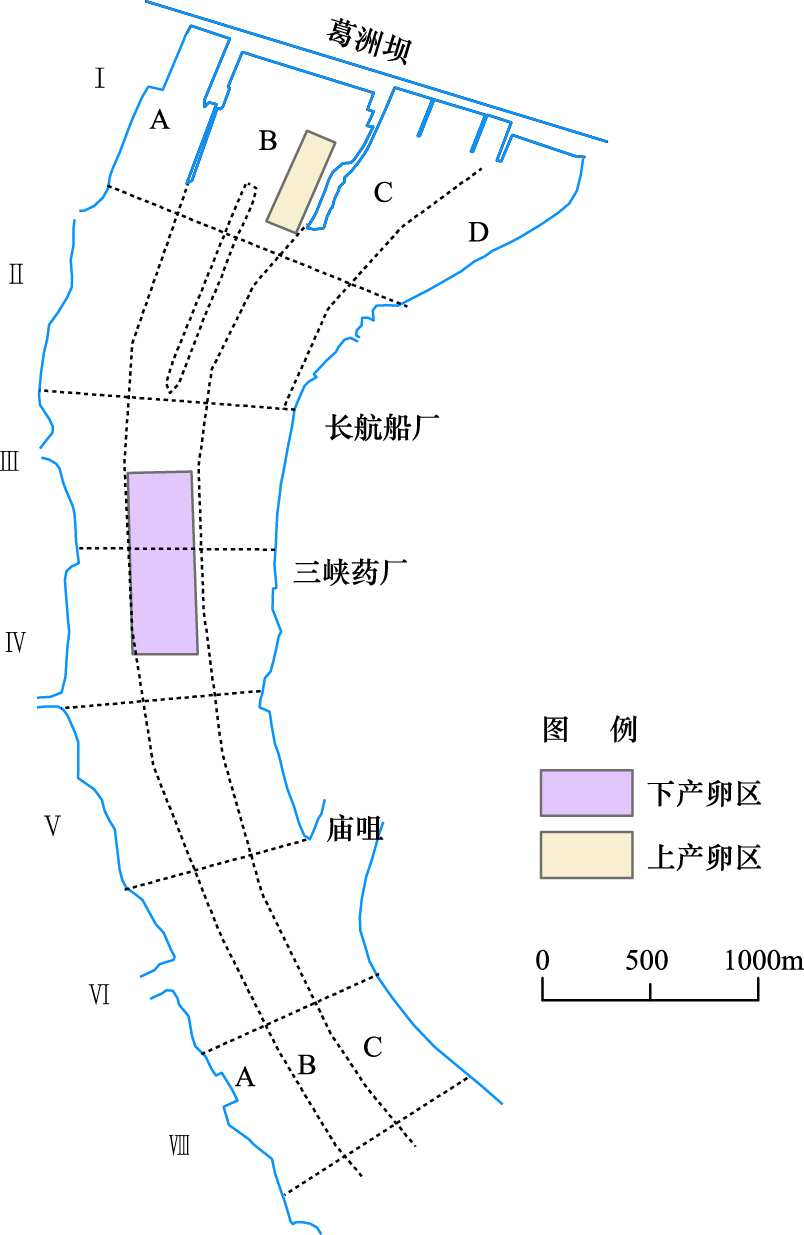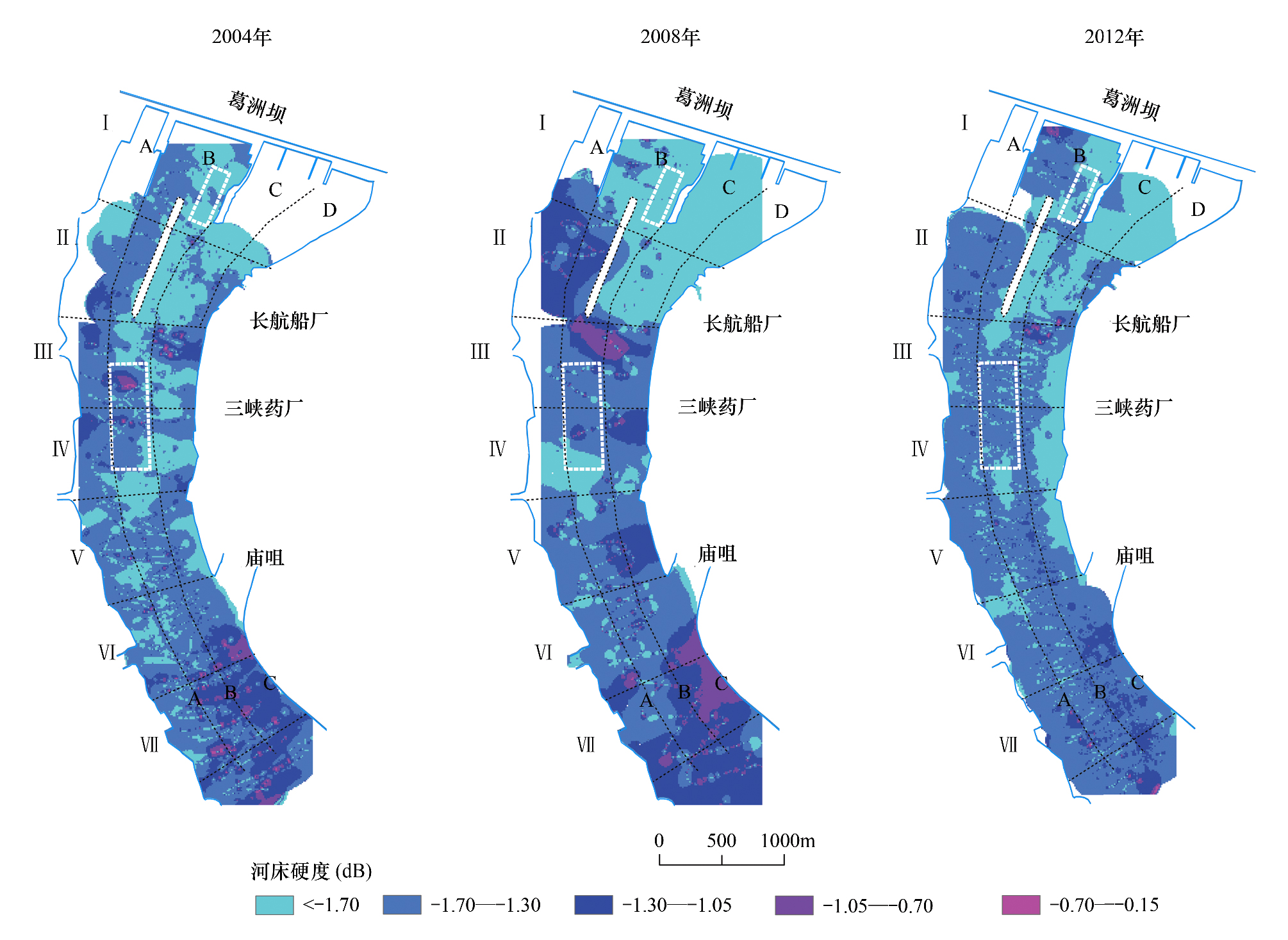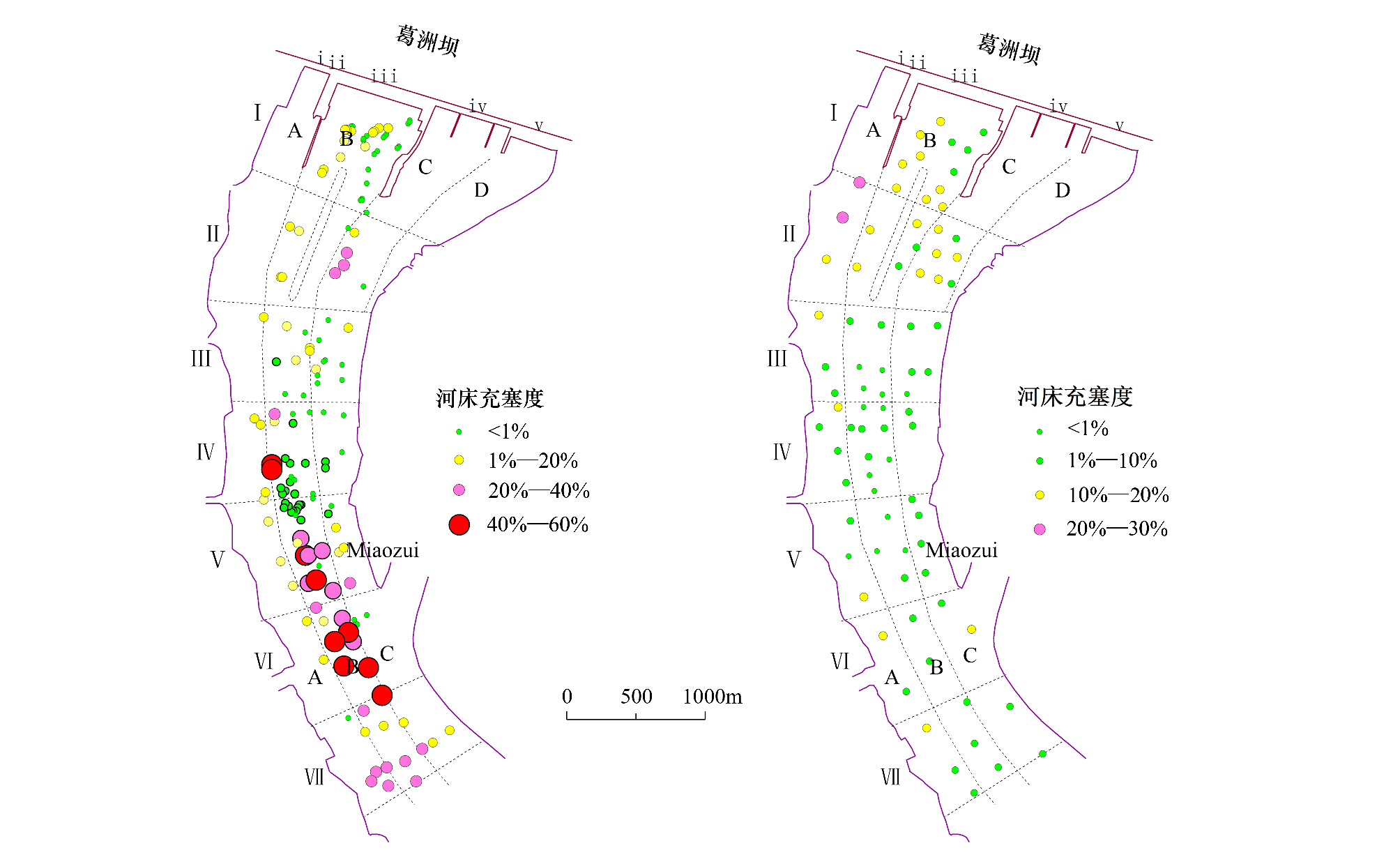文章信息
- 杜浩, 危起伟, 张辉, 王成友, 吴金明, 沈丽
- DU Hao, WEI Qiwei, ZHANG Hui, WANG Chengyou, WU Jinming, SHEN Li
- 三峡蓄水以来葛洲坝下中华鲟产卵场河床质特征变化
- Changes of bottom substrate characteristics in spawning ground of chinese sturgeon downstream the gezhouba dam from impounding of three gorge reservoir
- 生态学报, 2015, 35(9): 3124-3131
- Acta Ecologica Sinica, 2015, 35(9): 3124-3131
- http://dx.doi.org/10.5846/stxb201306141703
-
文章历史
- 收稿日期:2013-06-14
- 修订日期:2014-05-22
河床质是河流生物栖息地重要物理组成部分[1, 2]。对于底层产卵鱼类而言,河床质是其自然繁殖的承载体。水电建设、河势调整、防洪挖泥工程等人类活动造成的河床质的改变,会导致鱼类栖息生境的破坏和丧失[3, 4]。中华鲟为我国国家一级保护水生动物,产底层粘性卵鱼类,葛洲坝建成后其上溯洄游通道受阻,目前仅存坝下唯一一处自然产卵场。三峡工程蓄水水体含沙量下降,导致中华鲟产卵场河床不断被冲刷,势必对中华鲟产卵场河床质的物质组成、类型和镶嵌格局及其构建的微生境产生影响,进而影响中华鲟自然交配地点选择、早期胚胎发育,最终影响中华鲟物种的繁殖和存续。本文基于三峡蓄水以来葛洲坝下中华鲟产卵场水声学和水下视频观测结果以及中华鲟自然繁殖监测结果,力图揭示三峡蓄水以来葛洲坝坝下中华鲟产卵场河床质特征的变化情况及其对中华鲟自然产卵位点的潜在影响,为中华鲟自然繁殖河床质适合度及三峡蓄水清水冲刷作用的生态影响评估提供支撑。
1 研究方法 1.1 研究区域本研究所涉及的范围集中在紧邻葛洲坝下游约6km 江段范围内,涵盖了中华鲟产卵场范围(图 1)。其中,多年的监测结果显示,中华鲟产卵场范围内有两个集中的产卵点,分为上产卵区和下产卵区[5](图 1)。在长期的研究中,为了描述的方便,结合产卵场江段沿岸典型陆基参考将葛洲坝至下游分为多个横向分区(用I、II、III 等表示),同时基于河床宽度及葛洲坝布局特点,划分为多个横向分区(用A、B、C等表示)。其中I-B 和II-B区域内的空白区是自2004年起修建的一个隔流堤。

|
| 图 1 研究区域:葛洲坝下中华鲟产卵场 Fig.1 Study area: the spawning ground of Chinese sturgeon downstream from the Gezhouba dam (GZD) |
中华鲟主要产卵场所在的葛洲坝至十里红江段,河道走势呈弧形。在大江和二江电厂出水口前(即 I2-B 和 I2-C 区)分别形成一个较平坦急滩。急滩过后河床高程急剧下降形成一个陡坎,河床坡度值逐渐增大(I3-B—C 区),再加上受到大江电厂和二江电厂水流的强烈冲击,使此处的流态十分复杂。葛洲坝作为低水头径流式电站,水库基本无拦蓄作用,来水过程的特征基本不变。葛洲坝建成后坝下整体呈现粗化,原沙质河床转变为沙夹卵石或卵石夹沙河床[6]。
1.2 河床质特征水声学数据测量2004年至2012年,水声学调查在长江水产研究所每年开展的中华鲟自然繁殖生态调查期间(中华鲟繁殖季节10—11月份)进行,一般每隔2—3 d采用美国BioSonics 公司DT-X 系列数字科学回声系统进行河床质的探测[6]。探测采用“z”字型路线,探测范围从葛洲坝下至下游50—80 km不等,但均含盖了本研究区域。每年累计探测次数10—20次不等。
回声系统主要包括回声换能器、主机、JRC 卫星定位系统(误差小于15 m)和Dell D800 型工业笔记本电脑。换能器发射频率为199 kHz 的裂波,发射张角为6.8°,发射声强为221.0 dB//μPa,接收灵敏度为-51.3 dB//μPa。系统参数设置为每秒钟发射6 次脉冲,脉冲宽度为0.4 ms,40 TVG 时变增益,回声图入口阈值为-80 dB。采用科学回声仪配套软件Visual Acquisition 5.0.3 实时接收和存储所获取的声学数据。
1.3 河床质特征的水下视频观测2007—2012年,在中华鲟自然繁殖调查期间开展了水下视频观测[7]。调查采用以长30 m、宽8 m的机驳船前甲板为工作平台。在前甲板的船体边缘安装水文绞车。钢绳长50 m,装配50 kg铅鱼。用软钢丝绳将水下视频设备吊装在铅鱼上方1.5 m高处。视频采集时,先控制水文绞车用铅鱼探底后锚定船舶。然后将保护框架降至江底停留3—5 min拍摄后拖动钢丝使相机在铅鱼1.5 m范围内移动位置,记录采样点GPS位置。葛洲坝下及隔流堤处的视频观察采用85 HP快艇进行。
1.4 河床质特征参数的提取与分析BioSonic回声系统采集的河床质数据,包含的河床质第1次、第2次回波数据,可以用于分析河床的硬度、粗糙度、及河床沉积物等指标。通过BioSonic回声系统底质分析专用软件VBT (Visual Bottom Typer) 2.0处理软件在相同分析参数设置下获取相应数据。其中河床硬度值(Hardness),通过河床质一次回波信号的前半段回波信号强度值评估(单位dB);河床粗糙度(Roughness)由河床质一次回波信号的后半部分的回波信号强度值评估(3个脉冲长度,单位dB)[7]。
水下视频观测数据可以直观获得河床质组成和布局状态,获得河床表观充塞度(Embeddedness)数据。表观充塞度为单位视野面积中河床基质(粒径较大的砾石或卵石)的缝隙被河床推移质(粗砂、细砂)填塞的面积百分比(%)[7],反映的是河床表面细砂和粗砂沉积的状态。
1.5 中华鲟产卵位点定位中华鲟产卵区的精确定位采用江底采卵网和水下视频观测实现[5]。
1.6 数据处理与分析为了纵向比较年际差异,河床质水声学回波信号主要分析2004、2008和2012年的数据。河床质充塞度数据主要分析2008和2012年的数据。
将河床质硬度、粗糙度、充塞度数据导入到ArcGIS 9.2(美国ESRI 公司)进行表绘和分析。采用反距离权重插值算法进行插值分析,通过提取中华鲟上下产卵区的相关数据进行产卵位点特征的对比分析。采用SPSS 18进行统计和差异显著性分析和多重比较(Duncan,P<0.05)。
2 结果 2.1 中华鲟自然产卵发生位点通过江底采卵网监测和水下视频观测发现,中华鲟自然产卵位点自三峡蓄水(2003年)以来发生了明显的改变。其中,2003—2007年中华鲟仅在下产卵区产卵,2008—2012年中华鲟仅在上产卵区产卵。2008—2012年在上产卵区自然繁殖的规模和效果远远低于2004—2007年在下产卵区的产卵规模(危起伟等,未发表数据)。
2.2 河床硬度值变化水声学数据分析表明,三峡蓄水以来,葛洲坝下中华鲟产卵场硬度呈整体上升的趋势,2004—2012年整个产卵场江段的硬度均值未有显著差异,但局部区域河床硬度存在较大的差异,主要表现在Ⅵ区和Ⅶ区(图 2)。比较不同年份下产卵区位置的河床质硬度发现,随着三峡蓄水后清水下泄的冲刷作用,下产卵区河床硬度值增加,2004年和2008年的硬度值明显低于2012年(P <0.05)。而上产卵区的河床硬度则为2004年最大,2008年和2012年显著降低(P <0.05)(表 1)。在相同年份中,上产卵区的硬度值均显著大于下产卵区的硬度(P <0.05)。

|
| 图 2 中华鲟自然产卵场河床硬度回声值分布状况 Fig.2 Distribution of riverbed hardness echo strength of spawning ground of Chinese sturgeon in 2004,2008 and 2012 |
| 区域 Area | 河床硬度回声强度Riverbed hardness (dB) | ||
| 2004 | 2008 | 2012 | |
| 未标注相同字母实验组间存在显著性差异(Duncan氏多重比较,P<0.05) | |||
| 上产卵区Spawning sites upstream (SSU) | -1.40±1.05d | -1.52±1.52c | -1.52±1.52cd |
| 下产卵区Spawning sites downstream (SSD) | -2.00±2.00a | -2.00±2.00a | -1.70±1.70b |
| 整个区域Whole study area | -1.52±1.15cd | -1.70±1.40bc | -1.52±1.40cd |
水声学数据分析表明,三峡蓄水以来,葛洲坝下中华鲟产卵场粗糙度呈整体上升的趋势,2004、2008和2012年整个产卵场江段的粗糙度均值呈显著增加(P<0.05),其中Ⅵ和Ⅶ 区河床粗糙度变化明显(图 3)。下产卵区粗糙度2004年和2008年未有显著增加,2012年显著增加。各年际间上产卵区的粗糙度未有显著差异(P>0.05)。相同年际间比较发现,2004年和2008年下产卵区所在位置的河床粗糙度要明显低于上产卵区河床粗糙度,2012年未有显著性差异(表 2)。

|
| 图 3 中华鲟自然产卵场河床粗糙度回声值分布状况 Fig.3 Distribution of riverbed roughness echo strength on spawning ground of Chinese sturgeon in 2004,2008 and 2012 |
| 区域 Area | 河床粗糙度回声强度值 Riverbed roughness(dB) | ||
| 2004年 | 2008年 | 2012年 | |
| 未标注相同字母实验组间存在显著性差异(Duncan氏多重比较,P<0.05) | |||
| 上产卵区SSU | -1.30±1.15bcd | 1.22±1.22d | 1.22±1.15 cd |
| 下产卵区SSD | -1.70±1.15a | -2.00±1.70a | -1.40±1.52bc |
| 整个区域Whole study area | -1.40±1.22b | -1.30±1.15bcd | -1.22±1.10bcd |
从水下视频观测数据,可以直观获得中华鲟产卵场河床质的布局状态,依据水下视频对各采集点充塞度的观测表明,2008年度Ⅴ、Ⅵ和Ⅶ区的卵石缝隙充塞度达30%以上,明显有细砂和粗砂填充,在Ⅵ区域部分江段甚至全部为细砂(图 4,图 5),而2008—2012年逐年调查中,Ⅴ—Ⅶ区的河床细砂和粗砂明显被冲刷,

|
| 图 4 中华鲟自然产卵场河床充塞度状况 Fig.4 Distribution of riverbed embeddedness on spawning ground of Chinese sturgeon in 2008 and 2012 |

|
| 图 5 典型河床质充塞度视频图像 (白色虚线示砂填塞区域) Fig.5 Typical video image of the different riverbed embeddedness with 0%,3%,15% and 60% respectively (white broken line shows the area embedded with coarse or fine sand) |
| 区域 Area | 河床充塞度 Riverbed Embeddedness | ||
| 2008 | 2012 | ||
| 未标注相同字母实验组间存在显著性差异(Duncan氏多重比较,P<0.05) | |||
| 上产卵区SSU | (10±8)%c | (8±7)%c | |
| 下产卵区SSD | (3±5)%b | (4±5)%b | |
| 整个区域Whole study area | (15±12)%a | (6±8)%bc | |
卵石河床暴露。2008—2012年整个区域河床平均充塞度由15%下降到6%(表 3)。2008—2012年际间,上下产卵区的充塞度均无显著差异。但2008和2012年各年际内下产卵区大部分区域均为冲刷洁净的卵石河床(图 4),卵石缝隙中很少有砂填充,充塞度明显低于上产卵区(图 4,图 5)。
3 结论与讨论 3.1 主要结论三峡蓄水以来中华鲟产卵场河床质特征变化呈现以下几个特点:
1 )中华鲟产卵场整个区域内的河床硬度呈局部上升的趋势,但整个区域内未有明显的增加。下产卵区河床硬度明显增加,2012年显著高于2008年和2004年。上产卵区的硬度呈下降趋势,2008年显著低于2004年,2012和2008年该区域的河床硬度降低不明显。
2)中华鲟产卵场整个区域内的河床粗糙度呈显著上升的趋势。随着三峡蓄水清水下泄冲刷的持续,下产卵区2012年河床粗糙度显著高于2008年和2004年。上产卵区未有显著差异。
3 )中华鲟产卵场整个区域内的河床质充塞度呈显著下降的趋势,产卵场区域内的沉积细砂和粗砂明显减少。下产卵区随三峡蓄水冲刷作用,在2008年以后无任何填塞,卵石缝隙增大。上产卵区均有一定的充塞度,且2008和2012年间的河床充塞度未有显著的变化。
4)中华鲟自然产卵发生位点在2004—2012年期间有较大的变化,2004—2007年均发生在下产卵区,而2008—2012年均发生在上产卵区。上产卵区繁殖的规模和效果明显比下产卵区差,因此初步推断,河床硬度值、粗糙度及充塞度等特征是中华鲟自然繁殖河床质适合度的重要影响因素,可能是中华鲟产卵位点发生改变的原因。
3.2 讨论河床质作为河流生物栖息地物理生境的重要组成部分,其有关参数的测量仍主要通过底质采样、水下视频等方式实现。水声学测量以其数据收集便捷性及分析处理功能,在河床质分类中有广泛应用,但对于精细的河床质分类还存在一定困难。本研究试图将水声学与水下视频数据结合,对卵石夹砂类型的河床质特征进行评估。结果表明,水声学反映的河床硬度和粗糙度回波信号数据与河床卵石表观充塞度有一定的关联。从2007—2012年的对应结果显示,较低的充塞度(卵石缝隙中细砂较少)对应于较高的河床硬度和粗糙度。水声学回声信号的硬度和粗糙度值与卵石夹砂河床充塞度数据的关联模型将可为河流栖息地评估提供重要参数,值得深入研究。
鲟类为产江底粘性卵鱼类,其产卵基质一般要求硬质底质[9],大多要求卵石、砾石或基岩等,但也有报道产卵河床质为沙和泥[10]。中华鲟历史产卵场河床质特征常被描述为“卵石河床质”[11]。Bennett 等人发现一定程度的细砂覆盖对高首鲟的胚胎发育不利[12]。常剑波认为,刺激中华鲟产卵的外界因素,不是产卵场水文条件的变化,而主要是河床的底质状况[13]。基于本研究结果,中华鲟自然产卵位点在2008年发生了明显的迁移和改变,从下产卵区迁移至上产卵区,其河床质的变化特征是下产卵区充塞度下降,卵石暴露、卵石间缝隙明显增大,相应的硬度和粗糙度回声信号明显加强;而上产卵区的充塞度 、粗糙度未有显著差异,硬度有所下降。 可见一定程度的充塞度对中华鲟自然繁殖发生是有利的。过高和过低的充塞度可能不利于繁殖发生。中华鲟繁殖生物学特性似乎与这种生境需求一致。中华鲟繁殖发生后,受精卵开始分泌粘液,使得受精卵黏附在产卵基质上,经过4—5 d胚胎发育(18—20 ℃,约需要100—150 h),仔鱼破膜而出。刚孵出的仔鱼靠尾部的激烈摆动立即向水体上层游动,离开产卵场向下游降河洄游[14]。因此,河床卵石中较高的充塞度可能使得受精卵无法稳固附着,导致受精卵和胚胎随水流向下滚动,死亡率增加;如果充塞度很低,即卵石河床充分暴漏的情况下,卵石缝隙很大,这会导致受精卵会密集粘附沉淀在卵石缝隙里,这会限制胚胎之间氧气交换和代谢废物的排除,因此对中华鲟胚胎发育成活也不利。可以推断,2008年之后中华鲟自然繁殖活动放弃了以前多年以来的下产卵区(主要产卵区)的一个重要原因可能就是由于三峡蓄水冲刷导致的该区域充塞度的显著下降(卵石缝隙充分暴露,图 4)。多年观测研究表明,中华鲟自然繁殖发生时水体含沙量也处于中等水平[15],因此,水体中含沙量及河床质中的含沙量均有可能会对自然繁殖产生影响,值得进一步探讨。
本研究所获得的河床质硬度和粗糙度以及充塞度等河床质特征数据一定程度上反映了三峡蓄水以来对河床质特征变化的影响,基于以上分析,随着三峡蓄水运行带来的清水下泄冲刷作用的影响预测,中华鲟自然产卵场河床质适合度有进一步下降的可能,砂质补给等生态修复工程措施值得考虑,以维持这一濒危物种最后的繁衍空间。
致谢: 本研究得到中国水产科学研究院长江水产研究所原濒危鱼类保护组的杨德国研究员、陈细华研究员的帮助,特此致谢。
| [1] | McAdam S O, Walters C J, Nistor C. Linkages between white sturgeon recruitment and altered bed substrates in the Nechako River, Canada[J]. Transactions of the American Fisheries Society, 2005, 134(6):1448-1456. |
| [2] | McDonald R., Nelson J, Paragamian V, Barton G. Modeling the effect of flow and sediment transport on White sturgeon spawning habitat in the Kootenai river, Idaho. Journal of Hydraulic Engineering-Asce, 2010, 136(12):1077-1092. |
| [3] | Wang Z, Lee J H W, Xu M. Eco-hydraulics and eco-sedimentation studies in China. Journal of Hydraulic Research, 2013, 51(1):19-32. |
| [4] | 陈细华.鲟形目鱼类生物学与资源现状.北京:海洋出版社, 2007:1-203. |
| [5] | Wei Q W, Kynard, B, Yang D G, Chen X H, Du H, Shen L. Using drift nets to capture early life stages and monitor spawning of the Yangtze River Chinese sturgeon (Acipenser sinensis). Journal of Applied Ichthyology, 2009, 25:100-106. |
| [6] | Zhang H, Wei Q W, Kyanrd B E, Du H, Yang D G, Chen X H. Spatial structure and bottom characteristics of the only remaining spawning area of Chinese sturgeon in the Yangtze River. Journal of Applied Ichthyology, 2011, 27(2):251-256. |
| [7] | Du H, Wei Q W, Zhang H, Liu Z G, Wang C Y, Li Y H. Bottom substrate attributes relative to bedform morphology of spawning site of Chinese sturgeon Acipenser sinensis below the Gezhouba dam. Journal of Applied Ichthyology, 2011, 27(2):257-262. |
| [8] | Burczynski J. Bottom Classification. Seattle: BioSonics, Inc., 2001. |
| [9] | Bemis W E, Kynard B. Sturgeon rivers: an introduction to acipenseriform biogeography and life history.. Environmental Biology of Fishes, 1997, 48(1/4):167-183. |
| [10] | Arndt G M, Gessner J, Bartel R. Characteristics and availability of spawning habitat for Baltic sturgeon in the Odra River and its tributaries. Journal of Applied Ichthyology, 2006, 22:172-181. |
| [11] | 四川省长江水产资源调查组.长江鲟鱼类生物学及人工繁殖研究.成都:四川科学技术出版社,1988:1-284. |
| [12] | Bennett W R, Edmondson G, Williamson K, Gelley J. An investigation of the substrate preference of white sturgeon (Acipenser transmontanus) eleutheroembryos. Journal of Applied Ichthyology, 2007, 23(5):539-542. |
| [13] | 常剑波.长江中华鲟繁殖群体结构特征和数量变动趋势研究[D].武汉:中国科学院水生生物研究所,1999. |
| [14] | Zhuang P, Kynard B, Zhang L Z, Zhang T, Cao W X. Ontogenetic behavior and migration of Chinese sturgeon, Acipenser sinensis. Environmental Biology of Fishes, 2002, 65(1):83-97. |
| [15] | Yang D G, Wei Q W, Chen, X H, Liu J Y, Wang K. Hydrological Status of the spawning ground of Acipenser sinensis underneath the Gezhouba Dam and its relationship with the spawning runs. Acta Ecologica Sinica, 2007, 27(3):862-868. |
 2015, Vol. 35
2015, Vol. 35




